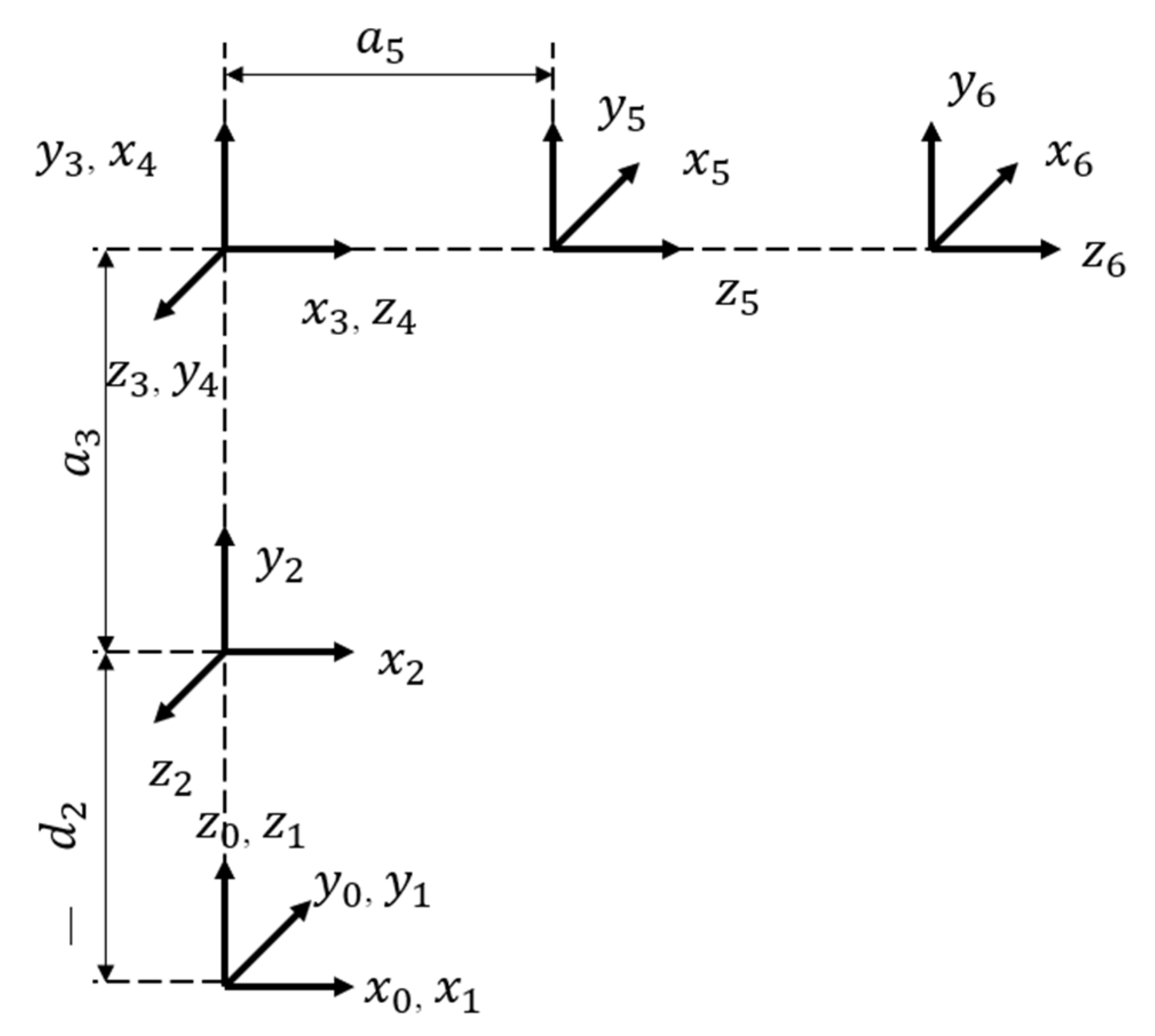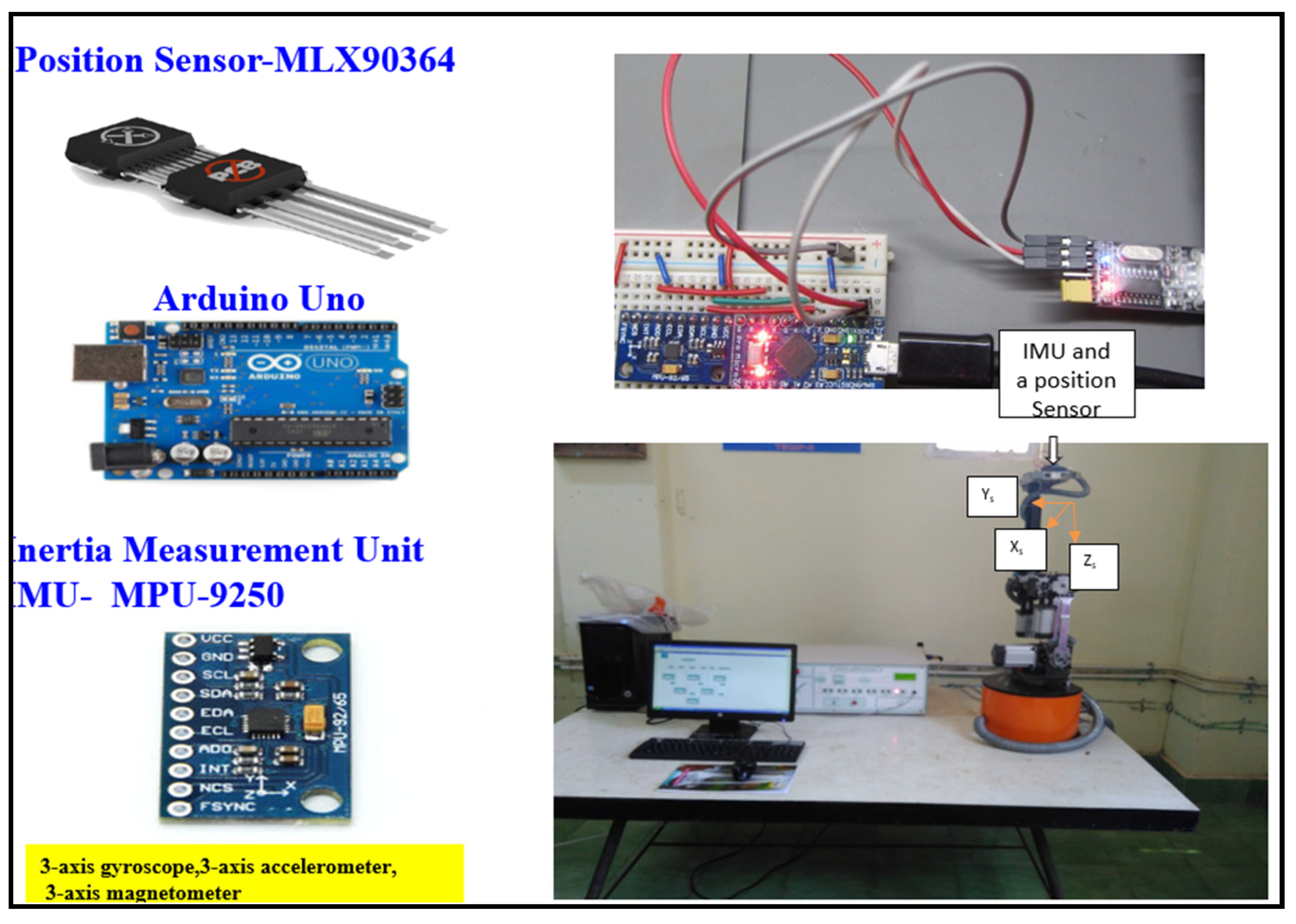Robust and Reliable State Estimation for a Five-Axis Robot Using Adaptive Unscented Kalman Filtering †
Abstract
1. Introduction
2. Kinematic Model of the Robot
3. Unscented Kalman Filter
3.1. Tuning Kappa
- 1.
- Density-based criteria: Maximum Likelihood Estimation (ML)
- 2.
- Moment-based criteria: minimizing measurement prediction error (MMPE)
3.2. Adaptation Parameters in UKF
- Step 1: The initial conditions prior to the estimations and are established. A set of criteria for dynamically and adaptively choosing the appropriate value is developed in order to optimize the performance and robustness of the filter.
- Step 2: The optimal is computed for the chosen criterion. The optimal scaling parameter in the maximum likelihood criteria was computed by the grid point method as . was chosen in such a way that its upper limit is . The central sigma point weight is and . To ensure a reliable and stable estimation procedure, the calculated covariance matrices were guaranteed with > 0.
- Step 3: and can be found as in Equations (7) and (8) for the chosen criterion and its optimal scaling parameter.
- Step 4: and can be obtained as in Equations (14) and (15) for the chosen criterion and its optimal scaling parameter.
4. Experiment
5. Results and Discussion
6. Conclusions
Author Contributions
Funding
Institutional Review Board Statement
Informed Consent Statement
Data Availability Statement
Conflicts of Interest
References
- Tang, G.; Liu, L. Robot calibration using a single laser displacement meter. Mechatronics 1993, 3, 503–516. [Google Scholar] [CrossRef]
- Lou, Q.; Gonzalez, F.; Kovecses, J. Kinematic Modeling and State Estimation of Exploration Rovers. IEEE Robot. Autom. Lett. 2019, 4, 1311–1318. [Google Scholar] [CrossRef]
- Smith, G.C.; Smith, R.A. A non-contact method for detecting on-line industrial robot position errors using a microwave Doppler radar motion detector. Int. J. Adv. Manuf. Technol. 2005, 29, 605–615. [Google Scholar] [CrossRef]
- Beravs, T.; Podobnik, J.; Munih, M. Three-Axial Accelerometer Calibration Using Kalman Filter Covariance Matrix for Online Estimation of Optimal Sensor Orientation. IEEE Trans. Instrum. Meas. 2012, 61, 2501–2511. [Google Scholar] [CrossRef]
- Won, S.P.; Melek, W.W.; Golnaraghi, F. A Kalman/Particle Filter-Based Position and Orientation Estimation Method Using a Position Sensor/Inertial Measurement Unit Hybrid System. IEEE Trans. Ind. Electron. 2010, 57, 1787–1798. [Google Scholar] [CrossRef]
- Du, G.; Zhang, P. Online Serial Manipulator Calibration Based on Multisensory Process Via Extended Kalman and Particle Filters. IEEE Trans. Ind. Electron. 2014, 61, 6852–6859. [Google Scholar] [CrossRef]
- Hartley, R.; Ghaffari, M.; Eustice, R.M.; Grizzle, J.W. Contact-aided invariant extended Kalman filtering for robot state estimation. Int. J. Robot. Res. 2020, 39, 402–430. [Google Scholar] [CrossRef]
- Šimandl, M.; Duník, J. Derivative-free estimation methods: New results and performance analysis. Automatica 2009, 45, 1749–1757. [Google Scholar] [CrossRef]
- Dunik, J.; Simandl, M.; Straka, O.; Kral, L. Performance analysis of derivative-free filters. In Proceedings of the 44th IEEE Conference on Decision and Control, Seville, Spain, 15 December 2005; pp. 1941–1946. [Google Scholar] [CrossRef]
- Wan, E.A.; van der Merwe, R. The Unscented Kalman Filter. In Kalman Filtering and Neural Networks; ch. 7; Wiley: Hoboken, NJ, USA, 2001. [Google Scholar]
- Duník, J.; Šimandl, M.; Straka, O. Adaptive choice of scaling parameter in derivative-free local filters. In Proceedings of the 2010 13th International Conference on Information Fusion, Edinburgh, UK, 26–29 July 2010; pp. 1–8. [Google Scholar] [CrossRef]
- Straka, O.; Duník, J.; imandl, M. Unscented Kalman Filter with Advanced Adaptation of Scaling Parameter. Automatica 2014, 50, 2657–2664. [Google Scholar] [CrossRef]
- Dunik, J.; Simandl, M.; Straka, O. Unscented Kalman Filter: Aspects and Adaptive Setting of Scaling Parameter. IEEE Trans. Autom. Control 2012, 57, 2411–2416. [Google Scholar] [CrossRef]
- Rhudy, M.; Gu, Y.; Gross, J.; Napolitano, M.R. Evaluation of Matrix Square Root Operations for UKF within a UAV GPS/INS Sensor Fusion Application. Int. J. Navig. Obs. 2011, 2011, 416828. [Google Scholar] [CrossRef]
- Julier, S.J.; Uhlmann, J.K.; Durrant-White, H.F. A New Method for the Nonlinear Transformation of Means and Covariances in Filters and Estimators. IEEE Trans. Autom. Control 2000, 45, 477–482. [Google Scholar] [CrossRef]
- Ding, W.; Wang, J.; Rizos, C.; Kinlyside, D. Improving Adaptive Kalman Estimation in GPS/INS Integration. J. Navig. 2007, 60, 517–529. [Google Scholar] [CrossRef]


| Joint | Link Twist α (Degree) | Link Length a (mm) | Link Offset d (mm) | Joint Angle ϴ (Degree) |
|---|---|---|---|---|
| 1 | 0 | 0 | 0 | 0–320 |
| 2 | −90 | 0 | 210 | 0–90 |
| 3 | 0 | 137 | 0 | 0–90 |
| 4 | 90 | 0 | 0 | 0–300 |
| 5 | 0 | 75 | 0 | 0–90 |
| 6 | 0 | 0 | 0–75 | 0 |
| State Description | Adaptive Scaling Parameter in UKF (κ) | ||||||
|---|---|---|---|---|---|---|---|
| UKF | MLE | MMPE | MLE | MMPE | MLE | MMPE | |
| ) | |||||||
| Position | 7.6532 | 4.6993 | 6.5215 | 3.5432 | 5.1642 | 2.9574 | 3.5237 |
| State Description | |||||||
|---|---|---|---|---|---|---|---|
| UKF | MLE | MMPE | MLE | MMPE | MLE | MMPE | |
| ) | |||||||
| Velocity | 13.842 | 9.950 | 11.161 | 7.654 | 10.347 | 4.862 | 5.918 |
| Acceleration | 9.075 | 5.368 | 7.439 | 4.182 | 5.984 | 3.374 | 4.120 |
| Average Filtering Covariance (VAR) | |||||||
|---|---|---|---|---|---|---|---|
| UKF | MLE | MMPE | MLE | MMPE | MLE | MMPE | |
| ) | |||||||
| 0.7542 | 1.1510 | 0.9631 | 1.2383 | 0.9856 | 1.3102 | 0.9891 | |
Disclaimer/Publisher’s Note: The statements, opinions and data contained in all publications are solely those of the individual author(s) and contributor(s) and not of MDPI and/or the editor(s). MDPI and/or the editor(s) disclaim responsibility for any injury to people or property resulting from any ideas, methods, instructions or products referred to in the content. |
© 2025 by the authors. Licensee MDPI, Basel, Switzerland. This article is an open access article distributed under the terms and conditions of the Creative Commons Attribution (CC BY) license (https://creativecommons.org/licenses/by/4.0/).
Share and Cite
Sundaram, G.; Bose, S.; Kandasamy, V.K.; Thandiyappan, B. Robust and Reliable State Estimation for a Five-Axis Robot Using Adaptive Unscented Kalman Filtering. Eng. Proc. 2025, 95, 1. https://doi.org/10.3390/engproc2025095001
Sundaram G, Bose S, Kandasamy VK, Thandiyappan B. Robust and Reliable State Estimation for a Five-Axis Robot Using Adaptive Unscented Kalman Filtering. Engineering Proceedings. 2025; 95(1):1. https://doi.org/10.3390/engproc2025095001
Chicago/Turabian StyleSundaram, Geetha, Selvam Bose, Vetrivel Kumar Kandasamy, and Bothiraj Thandiyappan. 2025. "Robust and Reliable State Estimation for a Five-Axis Robot Using Adaptive Unscented Kalman Filtering" Engineering Proceedings 95, no. 1: 1. https://doi.org/10.3390/engproc2025095001
APA StyleSundaram, G., Bose, S., Kandasamy, V. K., & Thandiyappan, B. (2025). Robust and Reliable State Estimation for a Five-Axis Robot Using Adaptive Unscented Kalman Filtering. Engineering Proceedings, 95(1), 1. https://doi.org/10.3390/engproc2025095001






